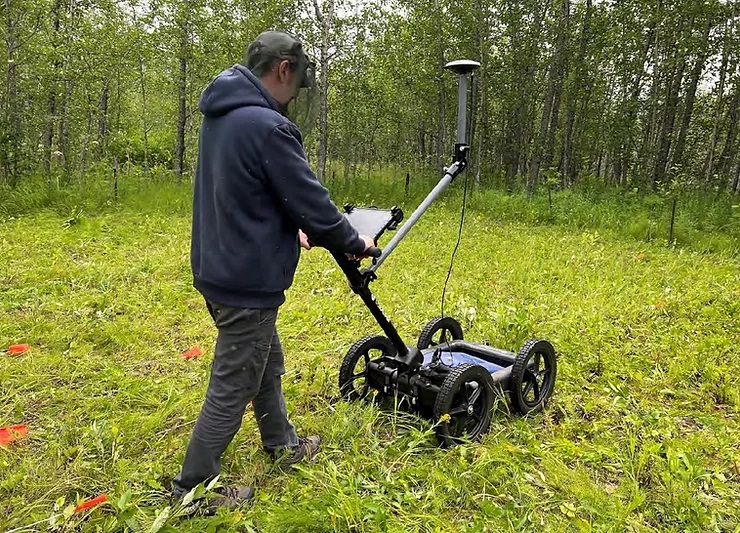Feature your business, services, products, events & news. Submit Website.
Breaking Top Featured Content:
Radar study reveals 1918 pandemic graves at cemetery near Nome

The results of a ground-penetrating radar study of the Pilgrim Hot Springs cemetery, located about 60 miles north of Nome, have been released.
The ground-penetrating radar study at the cemetery shows several anomalies consistent with previously unknown burials at the historic location, according to a statement from regional non-profit Native corporation Kawerak, on behalf of Unaatuq LLC, a non-profit which represents seven organizations with a stake in the property.
Those organization are Bering Straits Native Corporation, Teller Native Corporation, White Mountain Native Corporation, Mary’s Igloo Native Corporation, Kawerak, Inc., Norton Sound Economic Development Corporation and Sitnasuak Native Corporation.
The research was also conducted in partnership with the purpose of locating two communal and other unmarked graves. A total of 89 anomalies were identified to be consistent with human burials. That number increased to 93 after additional evidence was discovered in a fenced-in cemetery area.
More recent burials from the past 30 years were avoided during radar research, Pilgrim Hot Springs General Manager Amanda Toerdal said.
“We’ve known from some church records as well as documentation that there were two large graves within Pilgrim Hot Springs property, but there was never any confirmation of exactly where those were,” Toerdal said. “We discovered a partial diagram of the cemetery about two years ago, where it showed the two large graves from the Spanish flu, being in the fence cemetery areas.”
The research confirmed the location of a pair of mass graves from the 1918 Spanish influenza pandemic.
“First we found this partial diagram of the cemetery which showed those two graves, one with the 20 non-Catholic victims and then one with 41 Catholic victims,” Toerdal said. “Later, we discovered the fall cemetery diagram which also showed that same thing. Both graves are listed as 1918 but we haven’t found any other evidence on who is actually buried in the graves.”
There were two pandemic waves in Alaska from 1918 to 1919. Nearly two-thirds of influenza deaths in Alaska occurred in towns and villages in the Bering Strait region.
The 1918 influenza pandemic developed later here than other areas of the United States, according to research conducted by the state. Alaska appears to have been spared from the first wave that occurred in other areas in the summer of 1918.
Estimates of the numbers of deaths during the pandemic vary, but most deaths were among Alaska Native people, according to state officials.
Willa Ashenfelter, a member of the Native Village of White Mountain, says that during the 1918-1919 pandemic elders closed the village and kept most people out. That made a difference for those living there.
“The council at that time was very strict and kept visitors from coming in to White Mountain,” Ashenfelter said. “That’s what I grew up with, being told that was how it happened during the flu.”
Local burial sites that can be connected to the 1918 pandemic — through records held by the local Covenant Church — do exist, but not much is known beyond that, Unalakleet Mayor Abel Razzo said.
“I know that there are burial places across the river where the original site for the city used to be,” Razzo said. “As far as where they’re located, I’m not exactly sure. I do know that the church keeps records dating back I think to the early 1900s, but it doesn’t cover the location of where the folks are buried.”
Razzo added that no ground-penetrating-radar or similar research has been conducted in Unalakleet.
Today, fewer than 400 people live in Brevig Mission, but back in 1918, about 80 adults, mostly Inuit people, lived there, according to the Centers for Disease Control and Prevention. The impact of influenza on the village’s population was severe. During a five-day period between November 15-20 of that year, the pandemic claimed the lives of 72 of the villages’ 80 adults.
The village on St. Lawrence Island was not affected by the pandemic of 1918-1919 as badly as places on the mainland, mostly because of its relative isolation offshore, according to Gambell City Clerk Curtis Silook.
Kawerak is spearheading a plan to establish a cultural advisory committee that will examine the findings of the research, and investigate historic cemetery records and other documentation, to “identify, acknowledge, and honor those buried in the cemetery at Pilgrim Hot Springs,” Toerdal said.
A monument and interpretive signage are planned for the site to “pay their respects to those buried there,” according to Toerdal. She added that the BIA has assisted in that aspect of the plans at the cemetery and that a soon-to-be-formed cultural advisory committee will assist in making the monument a reality.
“(What comes next is to) try to come up with a design, to put up a monument or some sort of a commemoration of everyone who’s buried in the cemetery. Whether that’s a monument or a statue we’re not really sure what it looks like yet, because it’ll be up to this committee to decide that,” Toerdal said.
Kawerak is working to assemble a Pilgrim Hot Springs Cultural Advisory Committee, comprised of people having a direct or indirect relationship with the Pilgrim Hot Springs mission.
The committee will give guidance on how to best educate regional residents and visitors about the mission and orphanage as it relates to the people who lived there.
